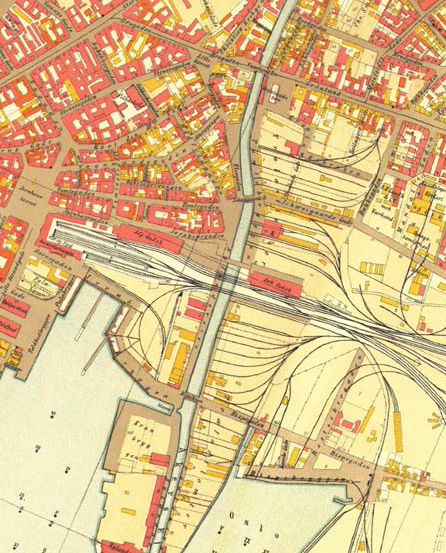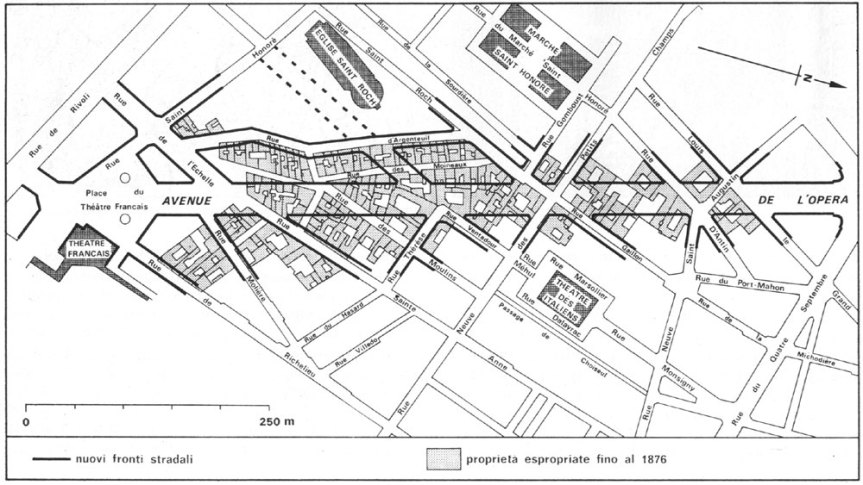Last week I had a good visit to Oslo and even had time to walk around in town. Letting myself go with the flow literally I tried to follow Akerelven out into the harbour of Oslo to reach the new Opera house. This turned out to be a bad decision since that led med to the area around the central station where the plans for an efficient traffic flow had been (partly i guess) realised. This meant that the existing urban fabric had partly rased to the ground and connected to this new industrialised structure in a way that looked like a primitive 1st generation cyborg.
This made me start wondering how this rather violent introduction of a new traffic centred regime into the the city would look if one compared it to Haussmanns boulevards in Paris. In the Paris case the main driving force behind bulldozing new boulevards through the existing fabric was to avoid a repeat of the Paris revolution in 1848 (building barricades in the narrow streets) and be able to move around large numbers off troops in town.
Reading texts on Mapping and the psychogeography of the Situationists I stumbled upon this text by Guy Debord: “Introduction to a Critique of Urban Geography” Published in Les Lèvres Nues #6 in 1955.
“The notion of utilitariness should be situated historically. The concern to have open spaces allowing for the rapid circulation of troops and the use of artillery against insurrections was at the origin of the urban renewal plan adopted by the Second Empire. But from any standpoint other than that of police control, Haussmann’s Paris is a city built by an idiot, full of sound and fury, signifying nothing. Today urbanism’s main problem is ensuring the smooth circulation of a rapidly increasing quantity of motor vehicles. We might be justified in thinking that a future urbanism will also apply itself to no less utilitarian projects that will give the greatest consideration to psychogeographical possibilities….This present abundance of private cars is nothing but the result of the constant propaganda by which capitalist production persuades the masses–and this case is one of its most astonishing successes–that the possession of a car is one of the privileges our society reserves for its privileged members”.
The Oslo vision was similar to the rest: separation of traffic and functions. Pedestrains were supposed to walk in 9 meters above the ground level that was reserved to the cars. You would be forced to follow the flow from transport hub to shopping hub to the conference centre. Only these two bridges were eventually build and lately sidewalks was added so the ground level was not only for cars.
Is it that simple that capitalism can be blamed for this inhuman way of working with the city? I think there might be more to it – like the wish to control or assert power over the city as a potentially organic and autonomous entity – as was the case with the boulevards of Paris. In the case of Oslo what struck me when I started to look at the plans was that one part of the traffic exchange was placed right over the river Akerelven that I tried to follow in vain. To me this seems quite irrational building it right there since the ground would be even softer and thus a more expensive place to build the foundations. It looks like this introduction of an mechanical element (the freeway system) into the city that had grown organically to that moment was also a way to squeeze out this trace of remaining nature in that part of the city. Somehow the result is much worse than Haussmanns boulevards in Paris. The question is if it is possible to reverse the mistakes.
Update.
Found this quote that might shed some light on the urge to “plow” freeways etc. through the city from THE POWER BROKER, Robert Moses and the Fall of New York, By Robert A. Caro
During construction of the Brooklyn-Queens Expressway, Moses rented the penthouse floor of the Marguerite Hotel—an old, sedate establishment right next to the expressway’s route—and used it as an office. It had two advantages: only a very few people knew of its existence, so he was interrupted by few telephone calls, and he could look down on the construction as he worked. And he spent a lot of time looking down at it, watching the cranes and derricks and earthmoving machines that looked like toys far below him moving about in the giant trench being cut through mile after mile of densely packed houses, a big black figure against the sunset in the late afternoon, like a giant gazing down on the giant road he was molding, “And I’ll tell you,” says one of the men who spent a lot of time at the old hotel with him, “I never saw RM look happier than he did when he was looking down out of that window,”






